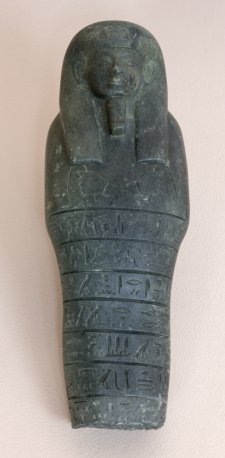Shawabti inscribed for the Chief of Miam, Heqanefer
Overview
Shawabti inscribed for the Chief of Miam, Heqanefer [ edit ]
The hieroglyphs on this small mummiform figure are from Chapter 6 of the Book of the Dead, and state that the statue will come to life to perform work on behalf of the deceased in the afterlife. Called a shawabti, from the ancient Egyptian word "to answer," this object did not belong to an Egyptian, but rather a Nubian prince named Hekanefer. A contemporary of the pharaoh Tutankhamun, Hekanefer had an important role in the Egyptian administration of Nubia (northern Sudan). In 1961, Yale Egyptologist William Kelly Simpson discovered Hekanefer's tomb at Toshka, saving the record of this amazing ancient monument and the memory of its owner from the rising waters of the Aswan High Dam.
The Chief of Miam, Heqanefer, provides unique insight into the Nubian role in New Kingdom imperialism. He is the only foreign individual, represented in an Egyptian tomb, for whom personal funerary material exists alongside information pertaining to his role within the Egyptian imperial administration in Nubia. Heqanefer’s career spanned, at least, the reigns of Amenhotep III (ca. 1390-1352 BC) to Tutankhamun (ca. 1336-1327 BC). Raised and educated in the Egyptian palace, he became chief of a Nubian district under the Egyptian viceregal administration. In this capacity, he oversaw the Nubian accumulation of tribute for presentation to the Egyptian king during the durbar ceremony, which bound the annexed Nubian territory to the Egyptian state. As chief, he liaised directly with the Viceroy of Nubia, Merymose, and later, Huy. Merymose and Heqanefer appear in a corpus of rock inscriptions in the Wadi Barramiya, the gold mines of Egypt’s south-eastern desert, the produce of which was earmarked for tribute. His role in the presentation of that tribute appears in the Egyptian tomb of the Viceroy Huy. His depiction there as archetypal Nubian chieftain contradicts his depiction in his own tomb, at Toshka, which is quintessentially Egyptian. The Egyptian character of his burial, as evidenced by this shawabti, is further emphasized by his rock inscriptions, which are similarly Egyptian in content and execution. The Heqanefer corpus and his administrative activities in Egypt and Nubia demonstrate a fluid conception of border and identity among Nubians during the New Kingdom, and reveal an Egyptian foreign policy that transformed Nubians into tools that reinforced Egyptian hegemony.
Period
New Kingdom
Dimensions
H. 7.5 in
Provenance
Toshka East
Material
Ceramic
Museum
Yale Peabody Museum
Accession Number
ANT 222265
John Coleman Darnell and Colleen Manassa, Tutankhamun’s Armies. Battle and Conquest during Ancient Egypt's Late 18th Dynasty, (New Jersey: John Wiley & Sons, 2007)
Marina Wilding Brown, Keeping Enemies Closer: Desert Graffiti and Role of the Viceroy in the New Kingdom Nubian Administration, (PhD diss, Yale University, forthcoming).































